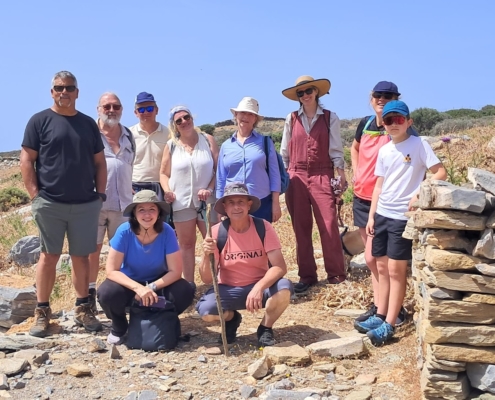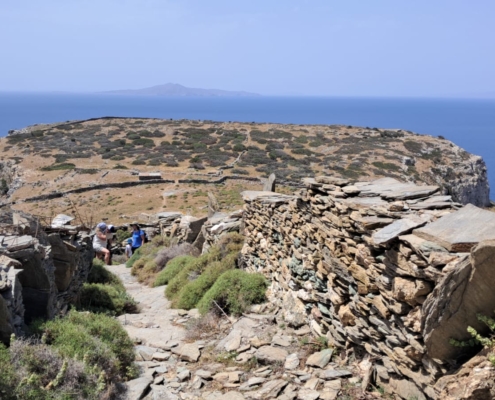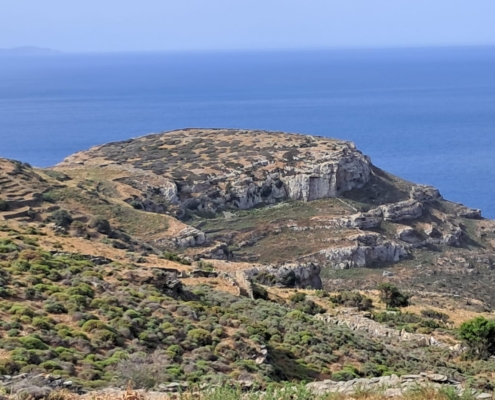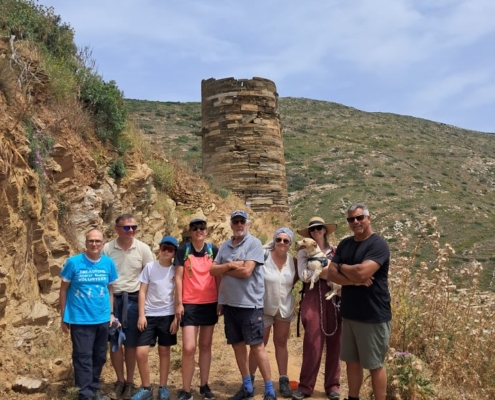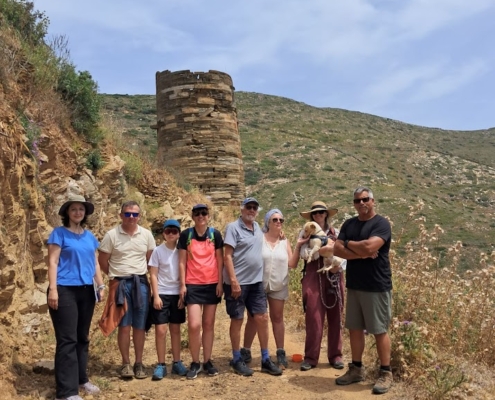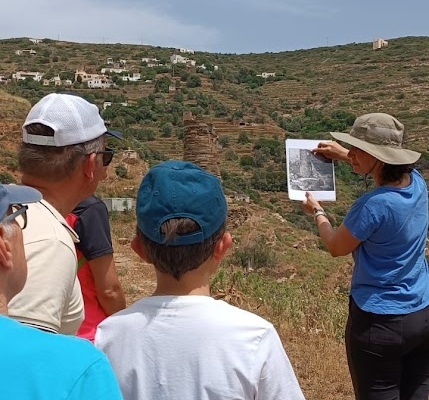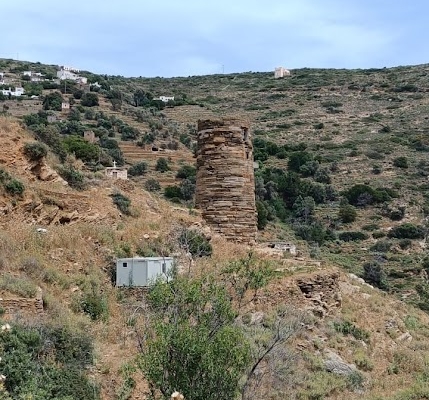Report of the guided tour of the archaeological site of Zagora & the ancient tower of Agios Petros
Green Cultural Routes 2025
Text: Alexandros Vrachnos, Katerina Pantazi
Photos: Alexandros Vrachnos, Kristen Mann
English translation: Katerina Pantazi
In collaboration with the Ephorate of Antiquities of Cyclades, as part of the Green Cultural Routes 2025 action, on Saturday, May 24, a visit and guided tour of the Archaeological Site of Zagora and the Ancient Tower of Agios Petros took place.
In a weekend full of local activities, 11 people from Chora, Strapouries, Kapparia, Aprovatou, as well as from France and the United Kingdom, gathered at the chapel of Agia Triada in the area of Stavropeda early in the morning, determined to discover ancient sites and stories of our island.
After a short hike on a section of the route waymarked as no. 7, we reached the archaeological site of Zagora, the Archaeologist of the Ephorate of Antiquities of Cyclades Eleni Kalavria guided us through the site, providing us with a lot of information. We were also accompanied by the archaeologist and Route Angel of the route Kristen Mann, who has participated for several years in the excavation of the archaeological site of Zagora.
Here are the main points:
The settlement of Zagora dates back to the Geometric period and remained active from 1100 BC to 700 BC. The site of Zagora is located on a small flat peninsula, naturally fortified, with almost vertical sides on three sides that are washed by the sea and only on the fourth side is it connected to the rest of the area by a narrow strip of land. The entrance to the settlement was on the side at the edge of the rock where it lost a gap of at least 100m to the sea for its protection from enemies.
Excavations have revealed the foundations of the settlement, where larger or smaller dwellings can be distinguished, storage areas for the crops and, at a central point, the foundation of an altar where the inhabitants seem to have gathered for their religious rituals. A short distance outside the settlement, a site that was probably a cemetery has been found, but no graves have been discovered. Also, in the surrounding area, people had their crops. Remarkable objects of daily use from the Geometric period have been discovered and are exhibited in the Archaeological Museum of Chora. It seems that they also had pitchers for transporting water, the walls of which were extremely thin, in order to be light, as they were made of clay that had particular strengths.
The settlement of Zagora was abandoned around 700 BC and the inhabitants moved to another area. However, their descendants returned to the abandoned settlement as pilgrims to the temple they built to celebrate until around 300 BC. They used the old houses as places to stay during the holidays. Archaeologists do not know why the settlement was abandoned, possibly due to climate change, perhaps the spring that was outside the walls and served it dried up, or because the port could not serve larger ships that began to be used.
To the right of Zagora, looking towards the sea, there is a similar rock/peninsula where the ancient settlement of Strofilas was located, which was inhabited from 4500 BC to 3000 BC.
After the archaeologists’ guided tour, we returned through the same path to our cars. Although the day was quite hot and the walking tiring, with great interest we set off for the second part of the tour to the ancient tower of Agios Petros.
Archaeologist Ms. Eleni Kalavria has conducted excavations at the imposing tower of Agios Petros, which dates back to approximately 300 BC, that is, the Hellenistic era, and through which the route waymarked as no. 15 passes.
According to research, the tower is believed to have been built by the owner of the nearby iron ore mine as a fortified residence. There is no evidence that it was an observation post that would signal the approach of an enemy.
The tower was constructed from oversized blocks of stone, especially those at the base, which were carved in an adjacent area, in a masterful manner using the then highly advanced construction technology.
It is approximately 20m high, while the first two floors are created by a vaulted structure at the base of the tower, with their own large entrance, without access to the main tower above, probably as a space where crops, materials, etc. were stored, while the main entrance to the tower is elevated at the height of the second floor and does not have a built staircase – it must have had a staircase that could be raised.
Another 5 floors appear to have been residential. It had windows only on the south side facing the sea, as well as a small balcony on two of the floors, where the fourousia still exist. On the north side it has small slits for ventilation. On one of the upper floors, it has been found that there was a small space for women’s “showers”, which is estimated as a hole protruding from the wall for the drainage of water is also visible. The steps of the internal circular staircase that served the floors have been built into the external stone walls.
The tour concluded with questions for the archaeologist and a discussion. It was a rich experience and we hope it will be repeated in the future for other monuments of Andros.
We warmly thank everyone who participated in the archaeological expedition, especially archaeologist Eleni Kalavria and the Ephorate of Antiquities of Cyclades.


